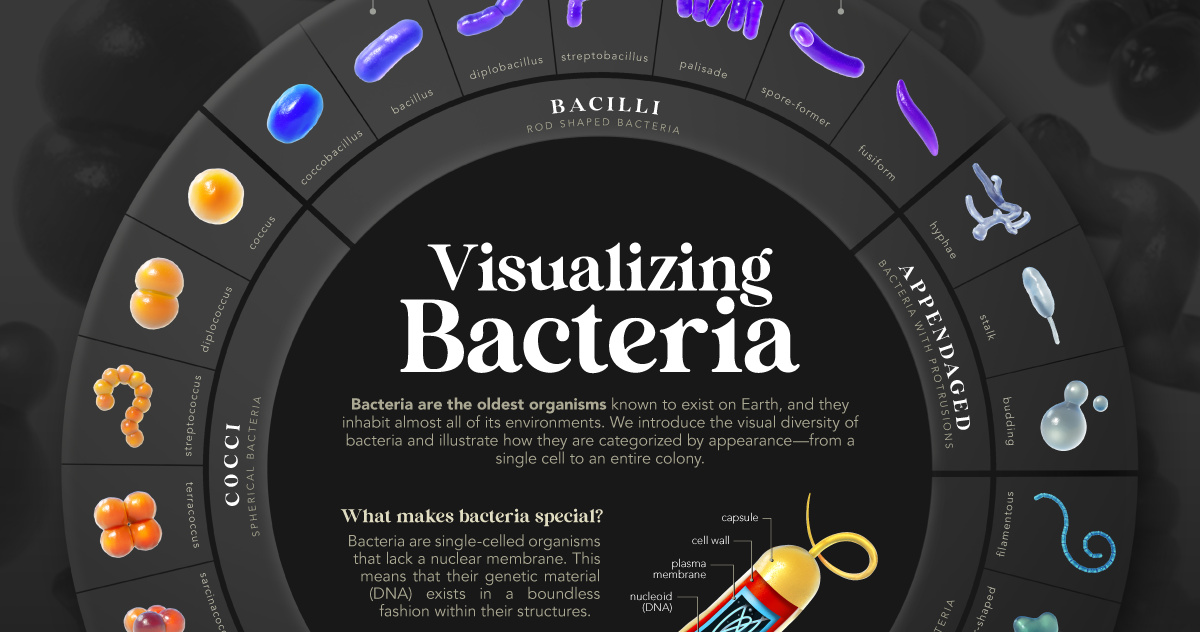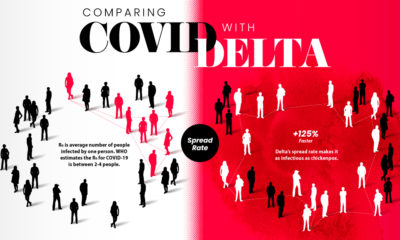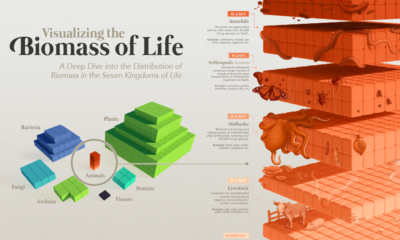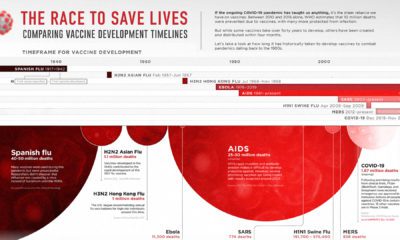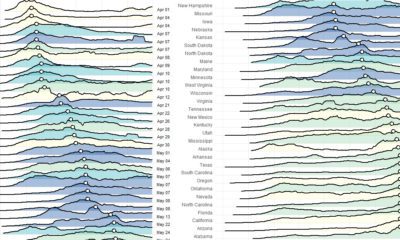Misc
Visualized: The Many Shapes of Bacteria
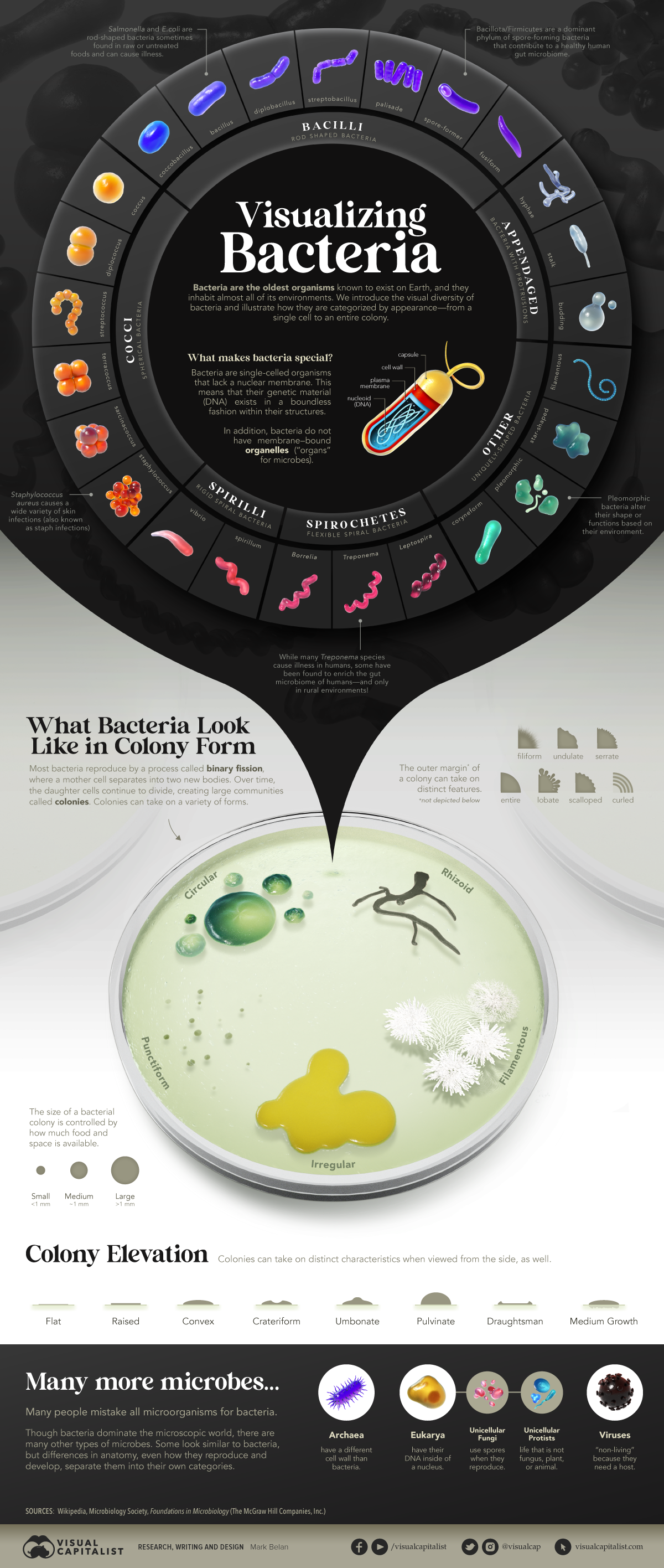
Invisible Diversity: The Many Shapes of Bacteria
Bacteria are amazing.
They were the first form of life to appear on Earth almost 3.8 billion years ago.
They make up the second most abundant lifeform, only outweighed by plants.
And most interesting of all: they exist in practically every environment on our planet, including areas where no other lifeforms can survive. As a result, bacteria exhibit a wide variety of appearances, behaviors, and applications similar to the lifeforms we see in our everyday lives.
The incredible diversity of bacteria goes underappreciated simply because they are invisible to the naked eye. Here, we illustrate how researchers classify these creatures on the basis of appearance, giving you a glimpse into this microscopic world.
A Life of Culture
Though bacteria may look similar to other microorganisms like fungi or plankton, they are entirely unique on a microscopic and genetic level.
Bacteria make up one of the three main domains of life. All life shares its earliest ancestor with this group of microbes, alongside two other domains: the Archaea and the Eukarya.
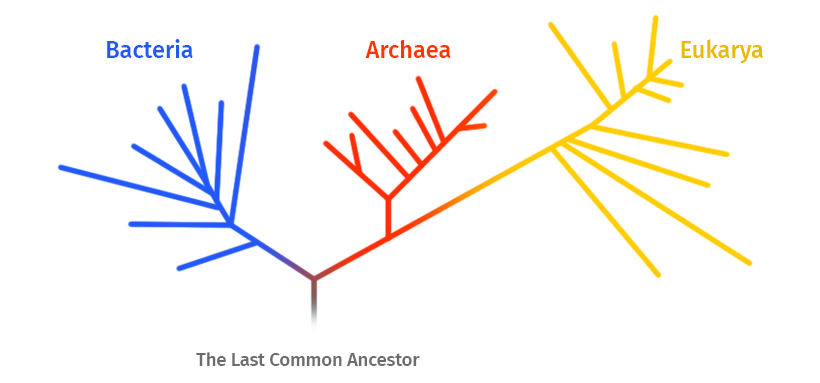
Archaea are very similar to bacteria, but have different contents making up their cell walls.
Eukarya largely consists of complex, multicellular life, like fungi, plants, and animals. Bacteria are similar to its single-celled members because all bacteria are also unicellular. However, while all Eukarya have nuclear membranes that store genetic material, bacteria do not.
Bacteria have their genetic material free-floating within their cellular bodies. This impacts how their genes are encoded, how proteins are synthesized, and how they reproduce. For example, bacteria do not reproduce sexually. Instead, they reproduce on their own.
Bacteria undergo a process called binary fission, where any one cell divides into two identical cells, and so on. Fission occurs quickly. In minutes, populations can double rapidly, eventually forming a community of genetically identical microbes called a colony.
Colonies can be visible to the human eye and can take on a variety of different shapes, textures, sizes, colors, and behaviors. You might be familiar with some of these:
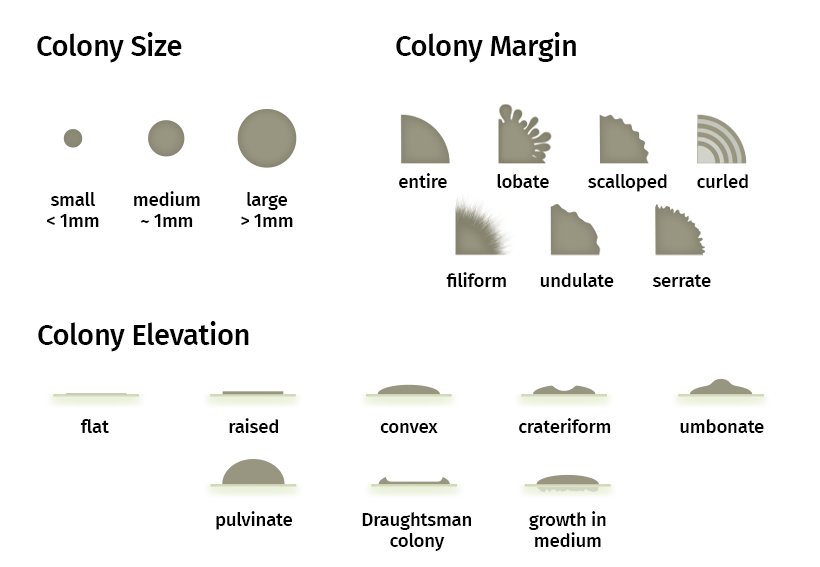
Superstars of a Tiny World
The following are some interesting bacterial species, some of which you may be familiar with:
Epulopiscium spp
This species is unusually large, ranging from 200-700 micrometers in length. They are also incredible picky, living only within the guts of sturgeon, a type of large fish.
Deinococcus radiodurans
D. radiodurans is a coccus-shaped species that can withstand 1,500 times the dose of radiation that a human can.
Escherichia coli
Despite being known famously for poisoning food and agriculture spaces from time to time, not all E.coli species are dangerous.
Desulforudis audaxviator
Down in the depths of a South African gold mine, this species thrives without oxygen, sunlight, or friends—it is the only living species in its ecosystem. It survives eating minerals in the surrounding rock.
Helicobacter pylori
Known for causing stomach ulcers, this spiral-shaped species has also been associated with many cancers that impact the lymphoid tissue.
Planococcus halocryophillus
Most living things cease to survive in cold temperatures, but P. halocryophillus thrives in permafrost in the High Arctic where temperatures can drop below -25°C/-12°F.
‘Bact’ to the Future
Despite their microscopic size, the contributions bacteria make to our daily lives are enormous. Researchers everyday are using them to study new environments, create new drug therapies, and even build new materials.
Scientists can profile the diversity of species living in a habitat by extracting DNA from an environmental sample. Known as metagenomics, this field of genetics commonly studies bacterial populations.
In oxygen-free habitats, bacteria continuously find alternative sources of energy. Some have even evolved to eat plastic or metal that have been discarded in the ocean.
The healthcare industry uses bacteria to help create antibiotics, vaccines, and other metabolic products. They also play a major role in a new line of self-building materials, which include “self-healing” concrete and “living bricks”.
Those are just a few of the many examples in which bacteria impact our daily lives. Although they are invisible, without them, our world would undoubtedly look like a much different place.
VC+
VC+: Get Our Key Takeaways From the IMF’s World Economic Outlook
A sneak preview of the exclusive VC+ Special Dispatch—your shortcut to understanding IMF’s World Economic Outlook report.

Have you read IMF’s latest World Economic Outlook yet? At a daunting 202 pages, we don’t blame you if it’s still on your to-do list.
But don’t worry, you don’t need to read the whole April release, because we’ve already done the hard work for you.
To save you time and effort, the Visual Capitalist team has compiled a visual analysis of everything you need to know from the report—and our VC+ Special Dispatch is available exclusively to VC+ members. All you need to do is log into the VC+ Archive.
If you’re not already subscribed to VC+, make sure you sign up now to access the full analysis of the IMF report, and more (we release similar deep dives every week).
For now, here’s what VC+ members get to see.
Your Shortcut to Understanding IMF’s World Economic Outlook
With long and short-term growth prospects declining for many countries around the world, this Special Dispatch offers a visual analysis of the key figures and takeaways from the IMF’s report including:
- The global decline in economic growth forecasts
- Real GDP growth and inflation forecasts for major nations in 2024
- When interest rate cuts will happen and interest rate forecasts
- How debt-to-GDP ratios have changed since 2000
- And much more!
Get the Full Breakdown in the Next VC+ Special Dispatch
VC+ members can access the full Special Dispatch by logging into the VC+ Archive, where you can also check out previous releases.
Make sure you join VC+ now to see exclusive charts and the full analysis of key takeaways from IMF’s World Economic Outlook.
Don’t miss out. Become a VC+ member today.
What You Get When You Become a VC+ Member
VC+ is Visual Capitalist’s premium subscription. As a member, you’ll get the following:
- Special Dispatches: Deep dive visual briefings on crucial reports and global trends
- Markets This Month: A snappy summary of the state of the markets and what to look out for
- The Trendline: Weekly curation of the best visualizations from across the globe
- Global Forecast Series: Our flagship annual report that covers everything you need to know related to the economy, markets, geopolitics, and the latest tech trends
- VC+ Archive: Hundreds of previously released VC+ briefings and reports that you’ve been missing out on, all in one dedicated hub
You can get all of the above, and more, by joining VC+ today.
-

 Education1 week ago
Education1 week agoHow Hard Is It to Get Into an Ivy League School?
-

 Technology2 weeks ago
Technology2 weeks agoRanked: Semiconductor Companies by Industry Revenue Share
-

 Markets2 weeks ago
Markets2 weeks agoRanked: The World’s Top Flight Routes, by Revenue
-

 Demographics2 weeks ago
Demographics2 weeks agoPopulation Projections: The World’s 6 Largest Countries in 2075
-

 Markets2 weeks ago
Markets2 weeks agoThe Top 10 States by Real GDP Growth in 2023
-

 Demographics2 weeks ago
Demographics2 weeks agoThe Smallest Gender Wage Gaps in OECD Countries
-

 Economy2 weeks ago
Economy2 weeks agoWhere U.S. Inflation Hit the Hardest in March 2024
-

 Green2 weeks ago
Green2 weeks agoTop Countries By Forest Growth Since 2001



